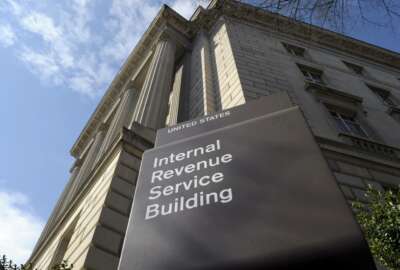
Biden administration’s skinny budget for the civilian side looks like a triple double X
Biden's $6 trillion for fiscal 2022 includes more than $100 billion increase in the so called discretionary spending to operate the government itself.
At $6 trillion for fiscal 2022, the Biden administration’s budget is nothing if not ambitious. It includes more than $100 billion increase in the so-called discretionary spending to operate the government itself. For early reactions in Congress and how the proposal is likely to fare on the hill, we turn to Bloomberg Government Editorial Director Loren Duggan.
Interview transcript:
Tom Temin: Loren, good to have you back.
Loren Duggan: Thanks so much.
Tom Temin: All right so just review for us the top line discretionary piece, as we understand it, from Friday’s release.
Loren Duggan: Sure, so that $6 trillion number is the total spending that would occur. Of that about 25% or $1.5 trillion would come on the discretionary side of the budget. And that’s where we see a great deal of the fight relations committee every year. That’s a routine process that they go through and figure out how to allocate that. Then to both defense programs and nondefense programs. So [one thing] that’s different this year than people who have been following this for the last several is there’s no Budget Control Act that sets a cap on the defense side and the nondefense side, that had been a real blocker at times for appropriators trying to do their work, because they would have to reach a deal to increase those caps to provide the level of spending that they wanted. Those caps are gone, something that Patrick Leahy, the chairman of the Senate Appropriations Committee, welcomed last week is kind of lifting a burden off of his shoulders to do his job, and in particular, provide money on the nondefense side of the ledger that he wants to see invested in different programs and kind of across the spectrum.
Tom Temin: Yeah, so we have a centrally a slightly-up budget on the Defense side, enough to – not even enough to cover the pay increase, actually. So they’re gonna have to make some tough decisions over there on the civilian side of the discretionary portion, then there is what a couple of hundred billion dollars more, none of that includes all these infrastructure ideas and so forth. So what is Congress likely to do when they get this plopped on their desks, as they return this week?
Loren Duggan: Right, and you touched on an important point there. There was a vote in the Senate weeks ago, unrelated to the budget, but on this bill dealing with competitiveness with China, and it was Richard Shelby, who’s the top Republican on the Appropriations Committee, and then Jim Inhofe, the top Republican on the Armed Services Committee. And they were trying to argue that you should have parity in increases. So if you’re going to increase nondefense, you should increase defense by the same amount. And they were tying it very specifically to the threats that they see needing to be countered with China. But their general ideas, we should have parity on both sides. So their amendment didn’t succeed, it didn’t have the majority vote that it needed. But it pointed to something Republicans are going to want, which is this increase in defense spending, and they will have a say in the Senate, where it still is going to take 60 votes, absent a change in the filibuster rules, for Democrats to get their spending bills across the line, either the Senate versions, or an eventual conference agreement that rolls everything together. So I think we’re gonna have to see how that one plays out over time. One of the things that may make it easier is if the chairman and ranking member on the House and the Senate side can come up with some top level numbers. If they have those top level numbers early, it can make the job of dividing money up among the bills a lot easier. So we’ll be watching to see once everyone’s back in town in June, if they can kick that off and really get that going.
Tom Temin: And from the proposal, what do the winners look to be which agencies?
Loren Duggan: Well, I mean, on the civilian side, most of them are getting pretty significant increases, sometimes even double-digit percentage increases. And I think one of the biggest is going to be the Department of Education, for example, which would get a major boost. Also things like which – not a big surprise, moving from the Republican Trump administration to the Democratic Biden administration, wanting more money over the Environmental Protection Agency. But that’s also just on the discretionary side, if you look at the two big proposals that are rolled into this – the American Jobs Plan, which is the infrastructure proposal the president has, and then the American Families Plan, which is more about social services, additional years of both early education and community college – if you piece all that together, you can see how that money is going to spider out through all the agencies when you have that mandatory money in that too. But obviously, there’s a lot of talk about infrastructure as well, which is a big portion of the jobs plan. And those negotiations are already on Capitol Hill. So we can see how some of the twists and turns have been there about how much money they really want to invest on Capitol Hill toward that sort of proposal.
Tom Temin: We’re speaking with Loren Duggan, editorial director of Bloomberg Government. And so for the Hill, then, they really have a lot of work to do, because, besides the usual work on that $1.5 trillion discretionary budget in the absence of caps, but in the absence also of agreement on what the relative size is and spending on the to Defense and civilian side should be, they’ve also got these gigantic proposals that are other bills, the infrastructure and so forth. And how are they going to digest all of this, in some way that’s meaningful?
Loren Duggan: It’s an excellent question. I mean, one of the nice things is you have committees that can divide this work up amongst themselves. So appropriators will be doing the bulk of the work on that $1.5 trillion in discretionary spending. But on the infrastructure side, we saw right before the recess, one of the key Senate Committees report out its portion of the surface transportation bill. That’s the Environment and Public Works Committee, that’s $304 billion already ready to go on traditional roads and highway projects. There’s still the transit portion there. And then the safety portion that also has to come out of the Senate package those together. On the House side, we’re seeing markups get scheduled for right after they come back in June to begin tackling some of those infrastructure questions. So in the House, it’s always a little bit easier, because once you package a bill together, you can send it to the floor, and the majority there can control time. Something gets on the Senate floor, there’s no telling how long it’s going to take or how many slowdowns you’re going to encounter. So I would anticipate a pretty busy summer on both floors, as they try to deal with all of these big packages and recess schedules and other scheduling wrinkles that they have going into September as well when they have to face that Oct. 1 fiscal year deadline. So you’re right, there’s a lot of issues to tackle here. Not a lot of time, I would anticipate, like I said, a very busy summer.
Tom Temin: And given the importance and level of disagreement with which they’re arguing all of these really big questions, then it would seem they should really work hard. You would expect them to work hard to avoid a continuing resolution come Oct. 1, because that solves nobody’s policy objectives – except, well, maybe the last budget, which is something the Biden administration would consider anathema. And so I wonder if this gives more impetus to actually maybe be on time for the first time in memory?
Loren Duggan: And I would also think that Democrats having control of the White House and both chambers will probably make that a goal to unified control, you want to make that kind of your pledge, as we have control over, we’re going to meet this deadline, but it’s going to be a very tall order to get all 12 bils to House and Senate committees and negotiated and, and through by Oct. 1. It is in the best of years, even, when you get a budget in February. And the appropriators this year got an inkling in April with the so-called skinny budget, and then have all the details now with what the Biden administration put out on Friday. So they’re going to be poring over this, they’ve done a lot of the work already with hearings and talking to Cabinet-level and sub-Cabinet-level officials is still going to be a tall lift. I would think that the CR talk, the continuing resolution talk will begin at some point in earnest, because there’s also going to be big issues this summer, like raising the debt limit or addressing that probably before they go away for the August recess if they need to. Because they don’t want that to pose any threat to government operations, obviously, while they were away in August, or in early September when the schedule is a little disrupted as well.
Tom Temin: And of course, overlaying all this is the one bill they do get done every year, which is the National Defense Authorization Act (NDAA) for 2022. And there’s a lot of policy writing, they’re developing with respect to sexual assault, domestic disturbances, and what’s the best format for handling those, that type of thing. What does that looking like?
Loren Duggan: Well, that’s gonna be another task that’s being delayed because of the slow release of the budget in the eyes, certainly, of those committees. We had Adam Smith over on the House side talking about that being delayed possibly even until September on the House floor, which will be very late. There’s years in the past when the period right before Memorial Day is the target to have that on the floor. So I think we’re gonna see a delayed action there, trying to get that up on the floors later this year. They have to choose between getting the spending bills done or the authorization bill, sometimes spending wins because that Oct. 1 deadline is a little harder and faster for the spending bills, but I would anticipate a lot of action on the NDAA as well and the sexual assault policy that you mentioned, that is going to be a big part of it. There’s a pretty bipartisan proposal in the Senate right now that some senators were trying even to begin debating outside of NDAA, although there seems to be a preference perhaps for waiting to debate that as part of the larger package. So that’s another marquee bill, on top of all the other ones we’ve discussed that is going to make up a pretty big chunk of Congress’s agenda.
Tom Temin: And do you think that they will skip some of the summer recesses they take?
Loren Duggan: I think there’s going to be pressure there just because of the amount of work they have to do and the number of items the Biden administration wants them to tackle. So some of those weeks that were initially committee weeks in the House where they would do things virtually, especially now with the coronavirus restrictions lifting I could see them in town trying to chip away both the committee work and some things on the floor. So we’ll be watching that very closely because it does affect vacation schedules.
Tom Temin: Yes and we’ll get to see what Nancy Pelosi looks like, again.
Loren Duggan: Everybody without their face masks. It’s a whole new world.
Tom Temin: All right. Loren Duggan is editorial director of Bloomberg Government. Thanks so much.
Loren Duggan: Thank you.
Copyright © 2025 Federal News Network. All rights reserved. This website is not intended for users located within the European Economic Area.
Tom Temin is host of the Federal Drive and has been providing insight on federal technology and management issues for more than 30 years.
Follow @tteminWFED





